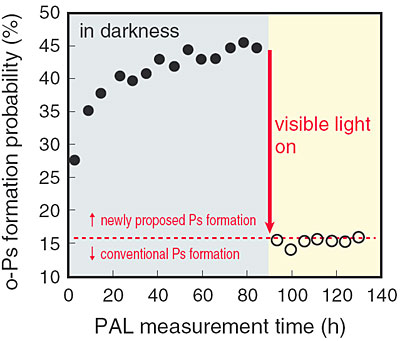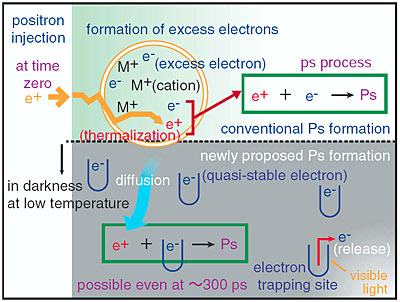The positron is the anti-particle of the electron. The masses of positrons and electrons are the same, but the charges are opposite. A positron and an electron can combine to make the bound state positronium (Ps). Electrons are always present in the orbitals of atoms and molecules. The energy required to release them is the ionization potential. This is usually more than 10 eV. On the other hand, the ionization potential of Ps is 6.8 eV. Therefore, electrons prefer to be on atoms or molecules. Hence, positrons cannot capture electrons from molecules to form Ps. However, if positrons are injected into molecular solids, liquids, or polymers, some of them will be able to form Ps. This is explained as follows. The injected positron can ionize some number of atoms or molecules, whereupon electrons are released. These electrons are called excess electrons. There are many excess electrons formed near an injected positron when it is thermalized. If the thermalized positron finds one of the excess electrons, Ps can be formed. This process of Ps formation probably occurs within several pico-seconds (ps). It is widely accepted as a major Ps formation process.
In the 1980's, slow enhancement of Ps formation at low temperatures (depending on the host material, below 170-220K) was observed, and the Ps formation process mentioned above could not explain this phenomenon. At low temperatures, molecular motions are frozen, and some of the excess electrons can be localized at suitable, stable trapping sites (indicated as a U-shaped potential in Fig. 8-4) to become quasi-stable electrons. The potential depth of such sites is about 0.5-3 eV. If there are many quasi-stable electrons, positrons which escape from the Ps formation process mentioned earlier can diffuse and find one of the quasi-stable electrons to form Ps (Fig. 8-4). This is a newly-discovered mechanism of Ps formation. However, quasi-stable electrons are released by exposure to visible light, as indicated on the lower right side in Fig. 8-4. In this case the new process of Ps formation will be quenched, and only the old Ps formation mentioned above will remain. The old process of Ps formation takes place within several ps. It was surmised that this new process of Ps formation might be possible even after several hundreds ps had elapsed, and now this has been confirmed experimentally.
The present studies offer a reasonable explanation for the mechanism of Ps formation that had been unclear for more than 10 years and further indicate that the Ps formation model only for polymers (as it is described even in textbooks) was not correct. Our work has created new research fields, and further studies of these phenomena are being conducted.
|


 : in darkness;
: in darkness;  : under visible light.
The most of conventional Ps formation is considered to occur until several ps by the reaction of one of excess electrons and the thermalized positron.
: under visible light.
The most of conventional Ps formation is considered to occur until several ps by the reaction of one of excess electrons and the thermalized positron.